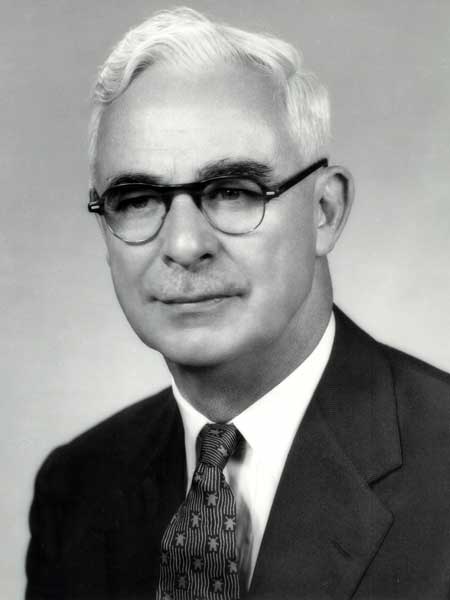 |
John Draper Perrin
|
Entrepreneur, businessman, financier.
Born at Medicine Hat, North-West Territories [now Alberta] in 1890, a son of William Perrin and Sarah Lytle (1861-1950), he resided in Winnipeg from 1899 and was educated in the public schools of Regina and Winnipeg, including Aberdeen School. He was employed with the Canadian Pacific Railway land office from 1906 to 1908; with McKenzie & Mann and Davidson & McRae from 1908 to 1913; engaged in mining, 1914 and active in that industry in the provinces of Ontario, Manitoba and British Columbia.
Perrin financed and developed the San Antonio Gold Mine and the Town of Bissett. He was President, Chairman, and Chief Executive Officer of the San Antonio Gold Mines Limited from 1931 to 1962. The San Antonio mine was the first dividend paying metals mine between the Great Lakes and the Rockies. Incorporated in 1931, the company was one of the first Manitoba corporations to achieve a listing on the Toronto Stock Exchange. In addition to Perrin, leading shareholders included Hollinger Mines and the Timmins family of Toronto. Both Noah Timmins and his nephew Jules R. Timmins served as Directors of the company. The first dividends were paid 15 March 1934 and by the mid-1930s Perrin’s business holdings had made him one of the wealthiest individuals in Canada, with a net worth of over $8 million. He was President of the Forty-Four Mines Limited, President of the Jeep Gold Mine Limited, and a Director of Macassa Mines Limited, NorMetal Mining Corporation, Quemeont Mining Corporation, Canada Talc Industries Limited, Canadian Metal Mining Association, the Mining Corporation of Canada Limited, and the Children’s Hospital of Winnipeg. He was a member of the Advisory Boards for the Royal Trust Company, the Canadian Red Cross, and the Winnipeg Football Club. He was Vice President of the Olympic Rink Limited, President and Chairman of the Board of Trustees of the Lakeside Fresh Air Camp, and a founding Director of Blick Broadcasting Limited.
Perrin was also interested in aviation and the use of aeroplanes in mining. He is credited with being the first person in the world to hire an aircraft to reach a remote mining site, having done so as early as 1919. In the 1930s he was one of the organizers of Wings Limited, an early air charter business, which was later bought out by Canadian Pacific Airways.
Between 1954 and 1959 Perrin financed and was President of the Winnipeg Warriors Hockey Club of the minor professional Western Hockey League. Along with his son J. D. (Jack) Perrin, Jr., as Vice President and General Manager, Perrin’s goal was to provide entertaining hockey to the citizens of Winnipeg in the then brand new Winnipeg Arena. In 1956, Perrin offered to purchase the Arena along with Winnipeg Stadium from the Winnipeg Enterprises Corporation, but a decision was made to maintain public ownership of the facilities. The Warriors in 1956 won the Edinburgh Trophy, emblematic of the Worlds Minor Professional Hockey Championship. In 1958, one of the Warriors junior teams, the Winnipeg Braves, won the Memorial Cup.
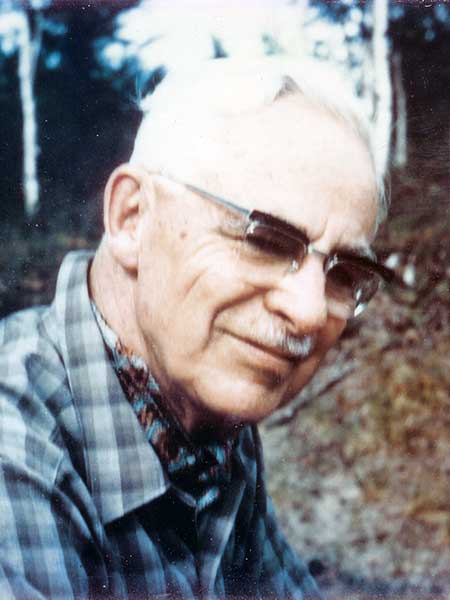 |
John Draper Perrin
|
In addition to his business interests, Perrin was a leading citizen and a noted philanthropist. During the Second World War he was the volunteer Chairman of the Greater Winnipeg Victory Loans Committee, part of the National War Finance Committee. As Chairman for all nine Victory Loans, he spearheaded efforts leading to a contribution to the war effort from the citizens of Winnipeg totaling the then enormous sum of over $100 million. During this time, Perrin also served as National Vice Chairman of the Canadian Red Cross Society Prisoners of War Parcels Committee and organized and served as sole Director of the Red Cross Parcel Packaging Plant located in the old Lombard Garage on the present site of Lombard Place in downtown Winnipeg, the only one in the West. With more than 900 volunteers working, 2,604,990 packages were sent overseas from Winnipeg. Following the war, he was one of several prominent financiers who played a role in helping to boost the post-war Winnipeg economy by providing venture capital to new businesses. Among these were some of today’s Winnipeg institutions such as Rae & Jerrys Steak House and radio station CJOB. In the early 1950s, Perrin declined an offer of appointment as Lieutenant Governor of Manitoba extended by Prime Minister Louis St. Laurent in recognition of his stature in the community and contributions to the province.
Beginning in 1948, Perrin served as Chairman of the Capital Campaign Committee of the proposed new Childrens Hospital, successfully leading fundraising efforts culminating in the 1956 opening of the new hospital on William Avenue. Perrin was also a principal benefactor of the Lakeside Fresh Air Camp for underprivileged children near Gimli MB. Active in his own neighbourhood Perrin co-founded with Mrs. Muriel Richardson the Crescentwood Homeowners Association, helping protect an important urban residential area from threatened development. As Chairman of the Building Committee he also led the successful efforts to build the new St. Georges Crescentwood Anglican Church.
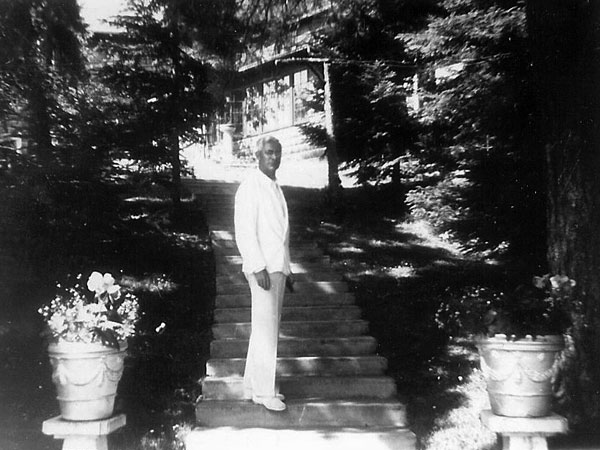 |
John Draper Perrin
|
In 1931, Perrin had purchased Rogers Island in Lake of the Woods from the Hon. Robert Rogers, who had built a camp at the south east end of the island around 1908. At the time of the purchase, Perrin granted Rogers the right to maintain a small camp at the north end of the island. Rogers had served as a cabinet minister in the provincial government of Rodmond Roblin and federal government of Robert Borden. In 1914, the camp had been greatly enlarged prior to a visit to the lake by the Governor General of Canada. The first member of the Royal Family to hold the office, HRH Prince Arthur, Duke of Connaught and his daughter Princess Patricia stayed on the island with the Rogers family. It was during this visit that the Duke suggested Lake of the Woods Yacht Club apply for use of the title “Royal”. With the support of the Duke, this title was later granted by HM King George V. By 1914 the Rogers camp had become a landmark on the lake just south of Devil’s Gap. The largest single owner island in the Kenora area, the property included tennis courts, a sandy beach, and a very large boathouse. The main camp provided 10 bedrooms and bathrooms , including two very large master suites. The living room area featured two curved staircases leading to a mezzanine balcony overlooking the main floor and the 24-foot tall windows facing south over the lake. A very large 8-spoke hand-painted chandelier, hand-carved from the trunk of a single tree by local aboriginal craftsmen, was suspended through the mezzanine balcony. A second historic visit to Rogers Island occurred in August 1929 when Winston S. Churchill, following in the Dule of Connaught’s footsteps, visited the camp following a speaking engagement at the Walker Theatre in Winnipeg. Several boats had been included in J. D. Perrin’s purchase of the island, including a 28’ mahogany Chris Craft Custom Runabout with the reputation for being the fastest boat on the lake. It was in this vessel that Winston Churchill toured the Lake of the Woods. The boat had been named “Robert R” by the Rogers family and J. D. Perrin re-christened her “Lady Ripples”, a name the boat retains to this day. During Perrin’s ownership, the Lady Ripples many times won the title as fastest boat on the lake at speeds of up to 45 mph. J. D. Perrin sold Rogers Island to J. M. Harris of Winnipeg in 1958 and the property fell into disuse and disrepair. In 1975, the main camp was destroyed by fire. The Harris family later subdivided a portion of the north eastern part of the island.
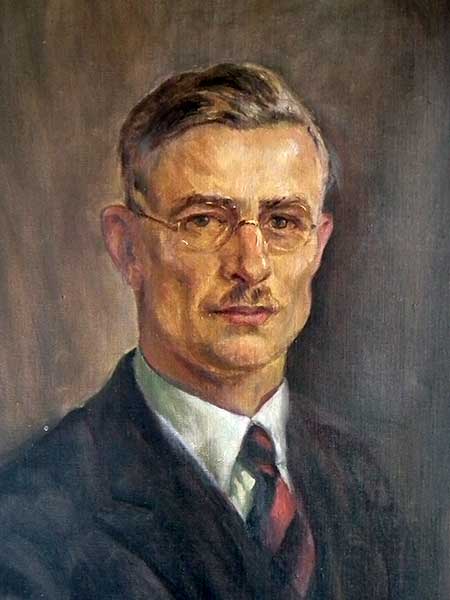 |
John Draper Perrin
|
In 1942, Perrin purchased from the Pilkington family of England a large 1,200 acre farm which featured five miles of river frontage along the south side of the Assiniboine River just west of Headingley, Manitoba. The CNR line through the area had included a small station and water tower for steam locomotives. The station was named Beaudry. Thus named Beaudry Farm, the property was later augmented with the purchase of a neighbouring farm bringing the property to 2,000 acres. The river frontage included much original river bottom forest, which was carefully preserved. Today, this property is known as Beaudry Provincial Park.
On 24 June 1914, he married Ruth Taylor Litle (1888–1986), daughter of William Litle of Calgary, Alberta. Together they had one son John D. Perrin, Jr. and three daughters, Alix Elizabeth Perrin (1919-2012, wife of W. J. Hopwood and Duncan J. Jessiman), Sarah Ruth “Sally” Perrin (1922-1941), and Marion Joan Perrin (1924-2015, wife of Duncan J. Jessiman).
Perrin was a member of the St. Charles Country Club, Manitoba Club (President in 1953-1954), Motor Country Club (Winnipeg), Boisclair Fish and Game Club, Canadian Institute of Mining and Metallurgy, Newcomen Society of England, Winnipeg Horsemen’s Club, Canadian Jockey Club, Royal Lake of the Woods Yacht Club, Canada Club of Winnipeg, York Club (Toronto), and the Liberal Party. He listed recreations as golf, fishing, and farming.
He died at his residence, 47 Harvard Avenue, on 19 September 1967, and he was interred in the St. John’s Cathedral Cemetery. Honorary pallbearers were E. H. Bennest, N. Brett, J. D. Bulgin, C. A. Campbell, J. N. Connacher, A. H. Harris, J. M. Harris, J. D. Sprague, G. L. Van Vliet, Dr. N. C. Carmichael, Dr. J. S. McInnes, and Dr. M. McLandress. Active pallbearers were his sons-in-law Duncan J. Jessiman and W. J. Hopwood, and his grandsons John D. Perrin III, Michael M. Hopwood, Jackson P. Hopwood, and Duncan D. Jessiman.
On 20 September 1967, his family received a letter from Premier Duff Roblin, which stated, in part, “With his passing the community loses an entrepreneur of great imagination and ability who played an active part and contributed much to the economic development of the West. He was an outstanding Manitoban and Canadian.” He is commemorated by the John Perrin Marsh at the Beaudry property that he owned from 1942 to 1967, now Beaudry Provincial Park.
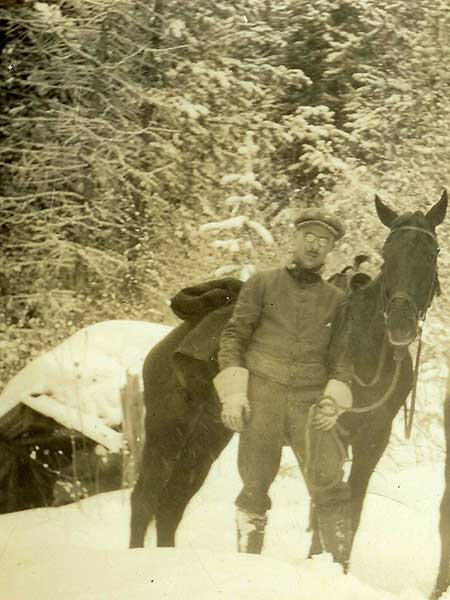
J. D. Perrin at Manigotagan (circa 1921)
Source: John Perrin III
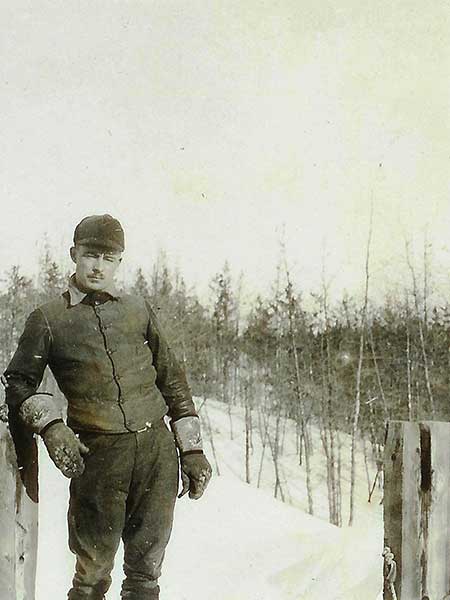
J. D. Perrin at San Antonio claim posts (circa 1925)
Source: John Perrin III
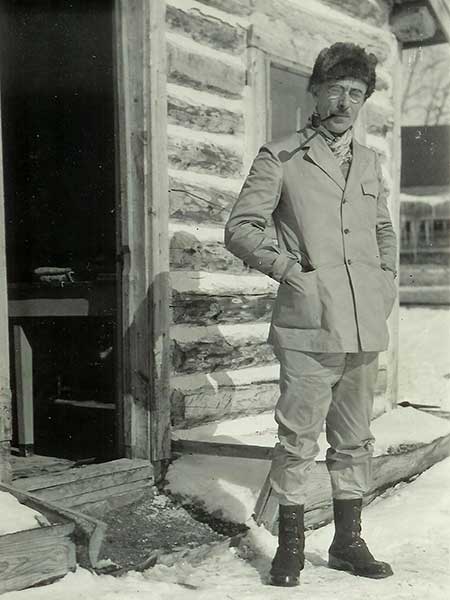
J. D. Perrin at San Antonio drill core office (circa 1934)
Source: John Perrin III
See also:
“You couldn’t run a game on Saturday night”: The Winnipeg Warriors, Television, and the Business of Pro Hockey, 1955-1961 by Morris Mott
Manitoba History, Number 27, Spring 1994Mining in Manitoba by George E. Cole
MHS Transactions, Series 3, 1948-49 SeasonHistoric Sites of Manitoba: Canadian National Railway Station (Beaudry, RM of Cartier)
Historic Sites of Manitoba: Robertson House (47 Harvard Avenue, Winnipeg)
The Northern Miner, 5 April 1934.
“Pupil fliers die in crash,” Winnipeg Free Press, 26 June 1942, page 1.
Winnipeg Free Press, 9 June 1944.
Minutes of a meeting of the National War Finance Committee, 21 October 1944.
Who’s Who in Canada, 1947-1948.
“He Mixes Mining, Horses and Fund-Raising,” Winnipeg Tribune, 7 July 1948.
Winnipeg Free Press, 19 October 1955.
Time Magazine, Canadian Edition, 21 June 1963.
“J. D. Perrin dies at his home,” Winnipeg Free Press, 19 September 1967, page 19.
Winnipeg Free Press and Winnipeg Tribune, various articles in the Sports sections, 1954 to 1960.
This page was prepared by John D. Perrin III.
Page revised: 3 June 2024
Memorable Manitobans
This is a collection of noteworthy Manitobans from the past, compiled by the Manitoba Historical Society. We acknowledge that the collection contains both reputable and disreputable people. All are worth remembering as a lesson to future generations.
Search the collection by word or phrase, name, place, occupation or other text:
Custom SearchBrowse surnames beginning with:
A | B | C | D | E | F | G | H | I | J | K | L | M | N | O | P | Q | R | S | T | U | V | W | Y | ZBrowse deaths occurring in:
1975 | 1976 | 1977 | 1978 | 1979 | 1980 | 1981 | 1982 | 1983 | 1984 | 1985 | 1986 | 1987 | 1988 | 1989 | 1990 | 1991 | 1992 | 1993 | 1994 | 1995 | 1996 | 1997 | 1998 | 1999 | 2000 | 2001 | 2002 | 2003 | 2004 | 2005 | 2006 | 2007 | 2008 | 2009 | 2010 | 2011 | 2012 | 2013 | 2014 | 2015 | 2016 | 2017 | 2018 | 2019 | 2020 | 2021 | 2022 | 2023 | 2024 | 2025 | 2026
Send corrections and additions to this page
to the Memorable Manitobans Administrator at biographies@mhs.mb.caCriteria for Memorable Manitobans | Suggest a Memorable Manitoban | Firsts | Acknowledgements
Help us keep
history alive!